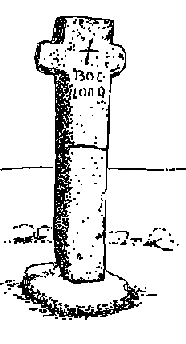 So
why have so many crosses been sited on a remote place like Dartmoor? There
are several reasons, but the main one is simply because Dartmoor is
so remote. In days gone by, travellers on the moor did not have any of
today’s navigational aids. It would have been easy to get lost on the
moor, especially at times when visibility was very poor. Many of the
crosses we see today were erected on the ancient tracks that were in
regular use in order to mark the way, particularly in the absence of other
natural landmarks, such as tors and prominent rocks.
So
why have so many crosses been sited on a remote place like Dartmoor? There
are several reasons, but the main one is simply because Dartmoor is
so remote. In days gone by, travellers on the moor did not have any of
today’s navigational aids. It would have been easy to get lost on the
moor, especially at times when visibility was very poor. Many of the
crosses we see today were erected on the ancient tracks that were in
regular use in order to mark the way, particularly in the absence of other
natural landmarks, such as tors and prominent rocks.
The ancient crosses do not have any religious significance as such, but it is more than probable that many on the South Moor were erected by the monks that regularly travelled between the abbeys at Tavistock, Buckland and Buckfast. You will see a number of these, such as Horn's Cross, Mount Misery Cross and Siward’s Cross being referred to as marking the way of the Monk’s Path. The ages of these crosses vary considerably from being relatively modern, less than 100 years old, to some which are believed to more than 1000 years old. Generally speaking, the older crosses were erected as either way markers, as described above, or as boundary markers as, for example Huntingdon Cross. As boundary markers, they have been used to mark the extent of a manorial estate or equally to mark the limit of a tin mining operation. A number of crosses, usually the more modern ones, have been erected for memorial reasons. In some cases, such as the Cave-Penney Cross, this is in remembrance of a relative who lost their life. In others, like the Hexworthy Cross, to commemorate an event such as Queen Victoria’s Diamond Jubilee. Most of Dartmoor’s crosses
have been carved out of single blocks of granite, the one main exception
being Widgery Cross which was constructed out of
a number of large granite blocks. Although some still exist intact today,
most of the ancient crosses have been thrown down at some time in the
past, either by cattle rubbing against them or by vandals, and have had to
be repaired and reset. The act of knocking the crosses down has caused
considerable damage to some, such as their heads breaking off, the shafts
fracturing into several pieces and even, in a few cases, the arms having
been deliberately knocked off in order for the remains to be used as a
gatepost.
However, due to a lot of hard work by bodies such
as the Dartmoor Preservation Society, the Dartmoor National Park Authority
and individuals, including William Crossing, a lot of time and effort has
been spent in repairing and restoring these crosses to as near their
original state as possible. In fact, one of the most difficult tasks was
to locate some of the missing crosses. In times gone past, it seems that
crosses were ‘fair game’ for moormen who were looking for a shaped
granite stone to use as a gatepost, a clapper bridge to span a stream or
even just a piece of stone to be built into a farm wall. Some of the crosses have had to be strengthened
by the use of iron clasps and, whilst these are not a pretty sight, they
do at least let us see the cross in one piece. There are also instances,
such as the Horse Ford Cross where parts of
the shaft could not be found and the cross has been reassembled from the
remains that were available. This now means that these crosses are a lot
smaller than the magnificent structures they once were. Our album does not yet cover all of the crosses
on and around the moor. As we continue to get out and about we hope to be
able to increase the number of crosses shown on our site and also be able
to add to the data already collected. Watch this space! |